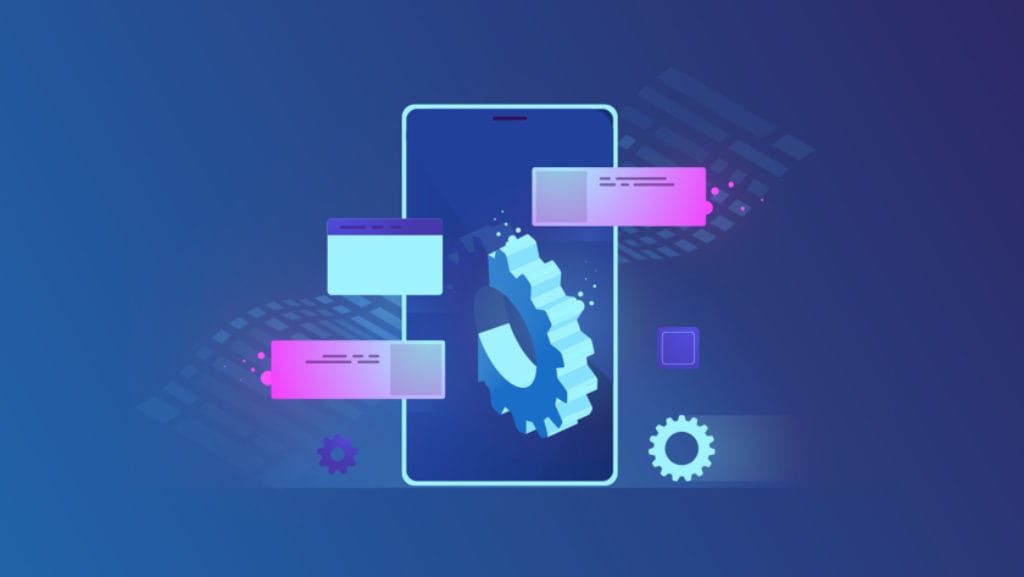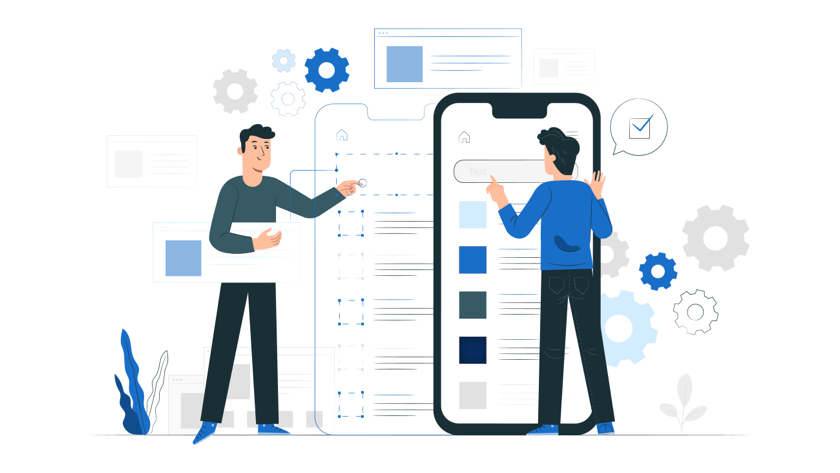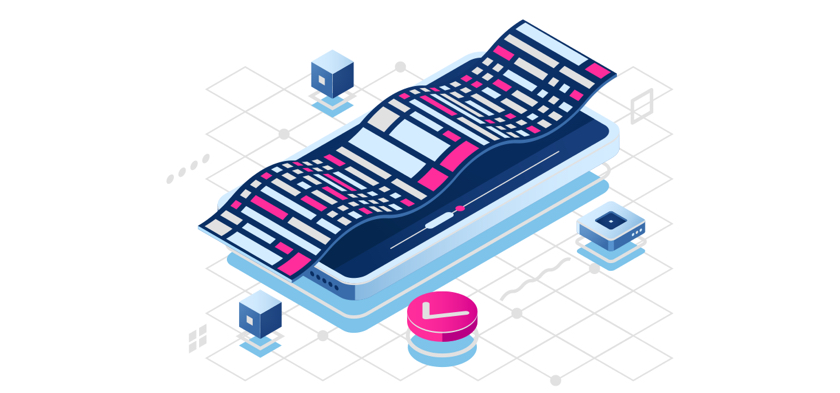Table of Contents
Many businesses are looking for ways to automate their processes, increase employees’ productivity, and add transparency to day-to-day communications and operations. This is what enterprise application development is all about. Think of Jira or Slack – these apps have become common tools for companies worldwide.
An enterprise mobile application may bring numerous benefits to your business as well as to your employees and customers. However, you can’t just go out there and create an app – it will have to meet specific requirements that we’ll discuss below.

What exactly is enterprise application development and what makes it different?
An enterprise mobile application is a large-scale and highly secure mobile application designed specifically for an enterprise and its needs. Unlike a common mobile application, an enterprise app usually has several clearly defined user groups, a very strict access control, and a complex architecture to manage all intended flows and processes.
We can define three main cornerstones of an enterprise application:
- Security: since enterprise apps process high volumes of sensitive information, security is top priority in the development of such apps.
- Scalability: because an enterprise is a large and complex organization, an app needs to be scalable to grow with the needs and the development of a company.
- Architecture: as already mentioned, an enterprise mobile application usually has a complex architecture to support all involved processes and workflows.
As for the types of enterprise mobile apps, there are three general types.
Employee-level
These apps are intended for internal use only and are used only by the employees. Normally, such apps facilitate communication between the employees and may assist them with completing certain tasks.
Employee-level apps usually include a small list of features and are not very complex in terms of functionality. However, they are still highly secure so don’t overlook this point. As for their main functions, they may include messaging, notifications, performance checking, or task tracking.
Department-level
Department-level apps can be used both internally (within a specific department) and externally (i.e. to communicate with customers). The main thing to remember is that these apps are designed for a specific department and their main goal is to facilitate and automate work within this department.
Hence, the functionality of such apps is usually very specific. As well, since these apps can be used by both employees and customers, there will be more user roles and different levels of access to take care of.
Company-level
The biggest and most probably the most complex type of enterprise apps is company-level. As the name implies, these apps are used within the entire organization and their main goal is to connect all departments. With the help of company-level enterprise apps, executives and employees can communicate in a transparent and efficient manner, exchange documents and information, and have access to the database and information across different departments.
The biggest benefits of enterprise application development

Usually, when an enterprise requests the development of a mobile application, it has specific goals in mind. Here are the main advantages of enterprise mobile apps that help organizations meet their business objectives:
- Automation: mobile applications can automate a number of tasks, i.e. document transfer or progress tracking. In this way, an app helps boost the overall productivity and speed of work and allows users to focus on more important tasks.
- Transparency: in big organizations with many departments, the lack of transparency is often an issue. A mobile application eliminates the problem by storing all needed information in one place and making it accessible for all authorized users. As well, the app eliminates and automates many steps involved in the information request process.
- Streamlined workflow: an enterprise mobile application keeps all workflows in one place, automates them, and optimizes the processes to the extent needed for efficient performance.
- Better and more secure data management: since any enterprise processes and stores a great amount of sensitive information, an app introduces better access control, facilitates data management and sharing, and contributes to data security.
Of course, you’ll need to write down and define all your business objectives in order for an app to bring you maximal benefit. In addition to that, you’ll also need to consider certain do’s and don’ts of enterprise application development if you want the final product to meet your standards and needs.
The Do’s of enterprise application development
Below we list down several best practices for designing a secure and high-performing application. And even though we talk about enterprise-grade applications in this article, these tips can actually be applied to mobile development in general.
Pay attention to security
Security is one of the primary things to focus on during the enterprise application development so pay double attention to it. Unfortunately, the issue often remains overlooked and, as a result, companies suffer financial losses. One of the primary reasons for an organization to become a point of a hacker attack is due to an employee downloading a malicious mobile application – and that’s just one example.
In one of our past articles, we discussed the main ways to secure your mobile application. You can read the article in full detail here and below we list the main takeaways:
- Always provide high-level user authentication;
- Request all app users to create and use strong passwords;
- Encrypt the data that an app processes and stores;
- Pay attention to your server-side security and improve it, if needed;
- Regularly update the application and roll out needed security patches on time;
- Enhance your corporate network security.
- Design with scalability in mind
Scalability is another cornerstone of a successful enterprise mobile application. In terms of enterprise application development, scalability means the ability of an app to handle a growing number of users and a growing volume of requests to proceed.

In case you wonder why scalability matters so much, think of the following example: if the number of app users becomes too big, it will collapse the app and will crash its performance. No need to explain how this may impact your work processes. Hence, if you want to prevent such issues and if you are sure that your organization will keep growing, you’ll need to place primary focus on the app’s scalability. For that, the development team will have to properly configure both the app’s hardware and software and will have to thoroughly plan its architecture.
Enable integrations with existing systems
Any enterprise uses at least one type of specialized software, be it a payroll management system or a CRM system. Now, when you develop an enterprise mobile application, it is important that the app can be easily integrated into the current systems in use.
Why do you need that? Simply because the app will require access to the company’s information that might be stored across various systems. As well, the integration between an app and other systems will enable automation and a streamlined workflow as well as centralized information storage.
Decide on the app’s administration and user roles
A clear assignment of user roles and limitations of access is one of the ways to enhance the app’s security and prevent unauthorized use of the app. Because enterprise mobile applications imply having several user roles, hence, you’ll need different levels of permissions for each. As well, you’ll need to clearly define who will have the administrative rights and who will be managing the app. This is needed in order to protect sensitive data and to manage users properly.
And one more important thing: if your app will be used by both the organization (and its employees) and the customers, it might be a good idea to create two separate apps. This will facilitate the app’s maintenance and will make it easier to manage access to the app.
Make sure onboarding and training are user-friendly
One of the biggest things that enterprises tend to overlook is the process of onboarding and training. In order for employees to be comfortable with using an application, they need to learn how to use it first. And if you don’t make the training process easy and user-friendly enough, you might be in trouble.
Employee training is an obligatory process that needs to be well-defined and written down during the planning stage of the app development. If the training is cumbersome and complex, not only will employees lose time trying to figure things out but they will also see a significant decrease in productivity. Hence, it is vital to pay attention to the app’s onboarding process in order to help employees quickly get used to an application.
The Don’ts of enterprise application development
We’ve talked about the best practices for developing enterprise mobile apps. Now let’s discuss the main considerations and hidden rocks that you need to know about. Otherwise, you might face certain issues after the app launch and these issues may have a serious impact on your business both in terms of finances and customer loyalty.
Do not ignore continuous testing
While some still believe that testing should be done after developing the main functionality of a software product, more and more companies are now adopting continuous testing. Continuous testing means testing the app during every stage of the development process in order to timely identify any errors before moving to the next stage.
This approach is highly beneficial as it:
- Saves the development time and resources (you don’t need to redo everything upon finding a mistake);
- Provides immediate feedback on the product quality and allows implementing adjustments on the go;
- Enables faster testing due to a number of automated tests at every development stage.
We’ve discussed continuous testing in more detail in this article – please have a look to get a better understanding of the approach and its implementation.
Do not chase tech trends unless needed
One of the most common challenges that we face as a software development company is a tech stack from a client that consists of trendy technologies. While there is nothing wrong with tech trends and we recommend keeping an eye on them, sometimes they are simply not relevant to the particular needs of your project.
When talking about complex and large-scale projects (like an enterprise mobile application), it’s best to rely on proven and well-tried technologies that have big communities, extensive documentation, and good support. This is important because in case of any issue that you face you’ll be able to quickly recover and fix it. With new and trendy technologies, this may often be a challenge.
Do not design for one platform only
If you plan to create and introduce an enterprise mobile application to your organization, think about all possible devices and platforms that the app will have to run on. One of the things that clients tend to overlook is the diversity of possible platforms for an app to support.
When working on an enterprise-level application, decide whether you want a cross-platform app or two native apps for iOS and Android platforms. The choice will depend on several factors (i.e. budget, time, available resources) so if you are not sure about what option to select, we recommend consulting your software provider.
As well, the design must be responsive, meaning, it should look and function equally well on all intended platforms. This is the responsibility of a development company to deliver but you need to state what platforms the app should support.
Do not overload the app with functionality
When you have a big complex app, it might be tempting to overload it with features and fancy add-ons. But in reality, the bigger your app is, the simpler its functionality should be in order not to confuse users and provide maximal usability.

If you have a hard time selecting features for your app, you can write them all down and then sort all listed features by their priority, starting with must-have ones (high priority) and ending with the ones that can be excluded (low priority). Also, when assembling a list of features, make sure to create user stories and use cases (read about the difference between the two here). This will help you make sure that all features are used throughout the user journey and that there are no unnecessary ones.
Do not overlook the importance of UI design
This point relates to the one above – do not overlook the importance of good UX/UI. A good app design performs several critical functions:
- Guides the user towards the set goal;
- Assists in finding information;
- Highlights areas to pay attention to;
- Speeds up the user performance by navigating the user through the needed steps.
On the contrary, if the app has poor design and low usability, it will confuse the users instead of aiding them. This, in turn, may slow down the work across the department or across the whole organization, cause production delays, and other significant consequences.
Summing up
Enterprise application development is a complex process that involves many steps and the first one is the clear definition of your business objectives. Whether you want to buy a readymade solution or decide to build a custom mobile application, you’ll need to have a solid understanding of what the app should do and what value it should bring to the users. Otherwise, you’ll put yourself at risk of spending too much time and resources on redesigning and refining the product that you might not even need in the first place.


Comments